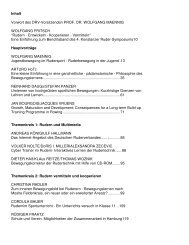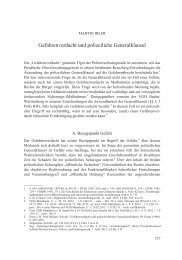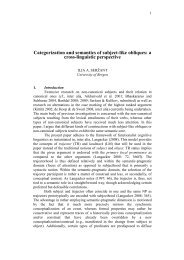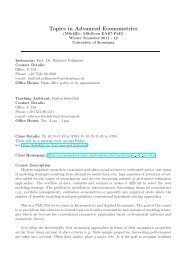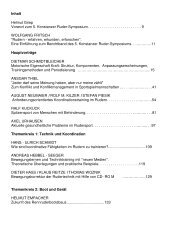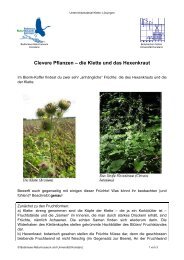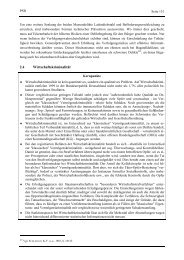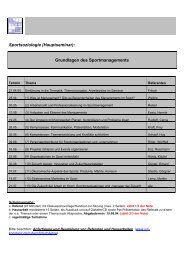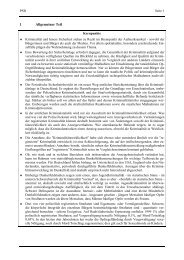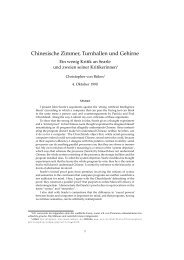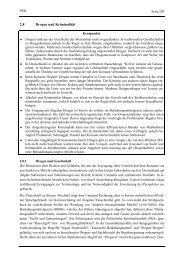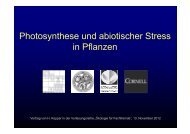Book of Abstracts Book of Abstracts - Universität Konstanz
Book of Abstracts Book of Abstracts - Universität Konstanz
Book of Abstracts Book of Abstracts - Universität Konstanz
You also want an ePaper? Increase the reach of your titles
YUMPU automatically turns print PDFs into web optimized ePapers that Google loves.
Self-Assembly <strong>of</strong> Metal Nanoclusters on Oxide Surfaces<br />
N. Berdunov 1 , G. Mariotto 1 , S. Murphy 1 , K. Balakrishnan 1 , Y. M. Mukovskii 2 , I. V. Shvets 1<br />
1 SFI Laboratories, Physics Dept., Trinity College Dublin, Ireland<br />
2 MISIS, Leninsky Prospect 4, Moscow 119991, Russia<br />
A - 33<br />
The self-assembly <strong>of</strong> ordered arrays <strong>of</strong> metal nanoclusters is a fascinating scientific<br />
phenomenon as well as a particularly promising subject for technological applications, such as<br />
microelectronics, ultra-high density recording, corrosion and catalysis. For example, magnetite<br />
and iron play an important role in industrial processes such as the production <strong>of</strong> hydrogen and<br />
the synthesis <strong>of</strong> ammonia. The ability <strong>of</strong> controlling the size and arrangement <strong>of</strong> Fe<br />
nanostructures may influence the way catalytic processes take place.<br />
We have studied the formation <strong>of</strong> Fe nanostructures on the magnetite (111) surface <strong>of</strong> single<br />
crystals and thin films. The Fe3O4(111) surface exhibits an hexagonal 42 Å superstructure, when<br />
annealed in oxygen atmosphere [1]. We have shown that this highly regular pattern is useful as<br />
a template for the self-assembly <strong>of</strong> nanostructures.<br />
We have deposited Fe films <strong>of</strong> 0.2, 0.5, 1 and 2 Å thickness at room temperature by means <strong>of</strong><br />
electron beam evaporation. STM images prove that ordered nucleation <strong>of</strong> nanoclusters takes<br />
place only on the patterned regions <strong>of</strong> the surface, while random nucleation takes place on the<br />
unpatterned regions (see Fig. 1). These results have been reproduced in the case <strong>of</strong> a 0.5 Å Cr<br />
film. The metal nanostructures are characterized by a very regular size distribution over a length<br />
<strong>of</strong> several hundreds nanometers.<br />
Our results demonstrate that the self-assembly <strong>of</strong> crystalline Fe and Cr nanostructures takes<br />
place on the preferential nucleation sites provided by the nanopatterned Fe3O4(111) surface. We<br />
suggest that ordered arrays <strong>of</strong> nanostructures could be grown on different oxides displaying<br />
long-range surface reconstruction, as recently demonstrated by the growth <strong>of</strong> ordered Pd<br />
clusters on Al2O3 [2].<br />
Figure 1. 80 nm × 80 nm STM image <strong>of</strong> 0.5 Å Fe deposited onto the Fe3O4(111) surface. Self-assembly <strong>of</strong> Fe<br />
nanostructures takes place only on the patterned areas <strong>of</strong> the crystal (terrace A), while Fe nucleates randomly onto the<br />
unpatterned areas (terrace B).<br />
References<br />
[1] N. Berdunov, S. Murphy, G. Mariotto and I.V. Shvets, Phys. Rev. B 70, 085404 (2004).<br />
[2] S. Degen, C. Becker and K. Wandelt, Faraday Discuss. 125, 343 (2004).<br />
151




